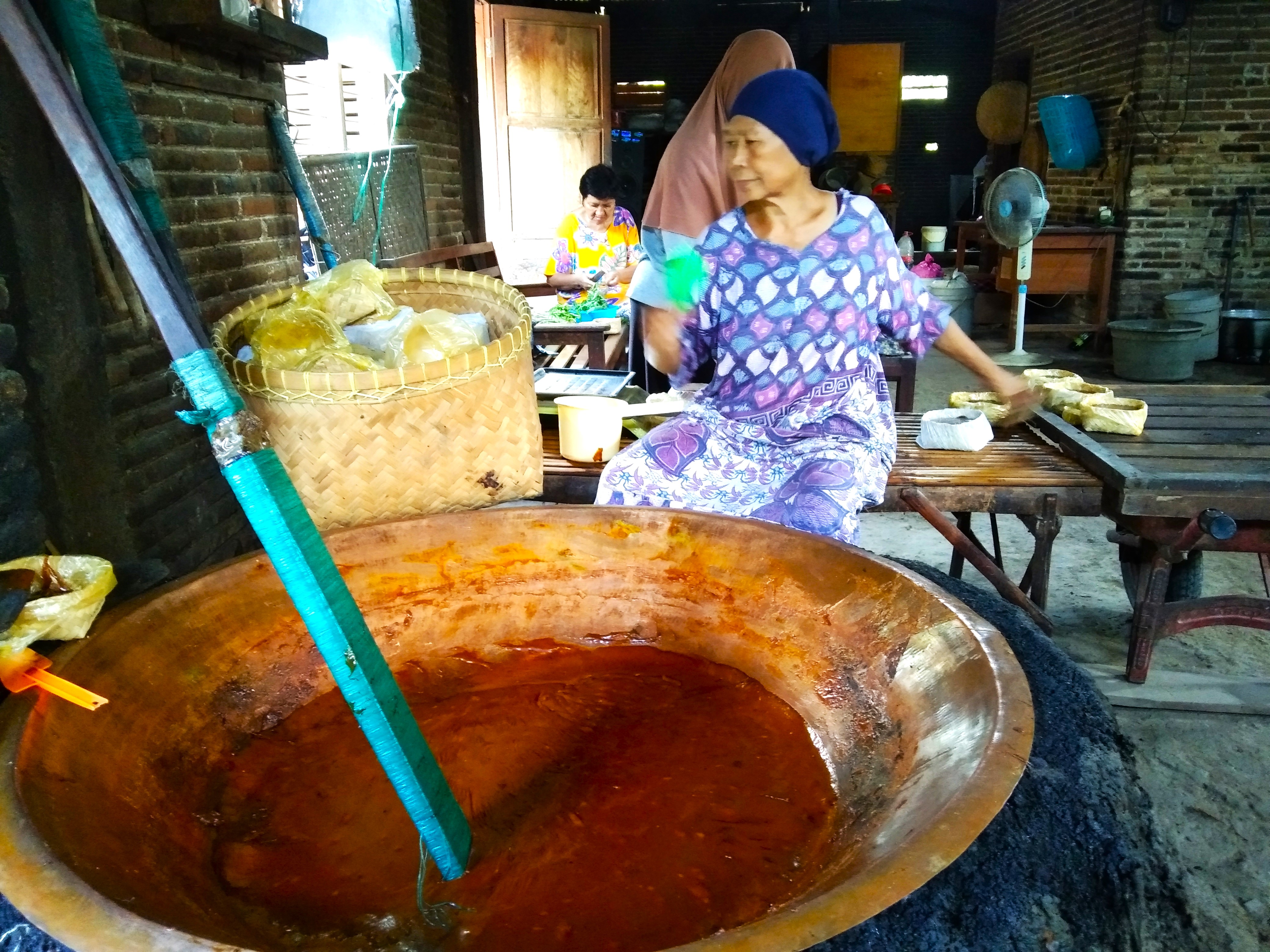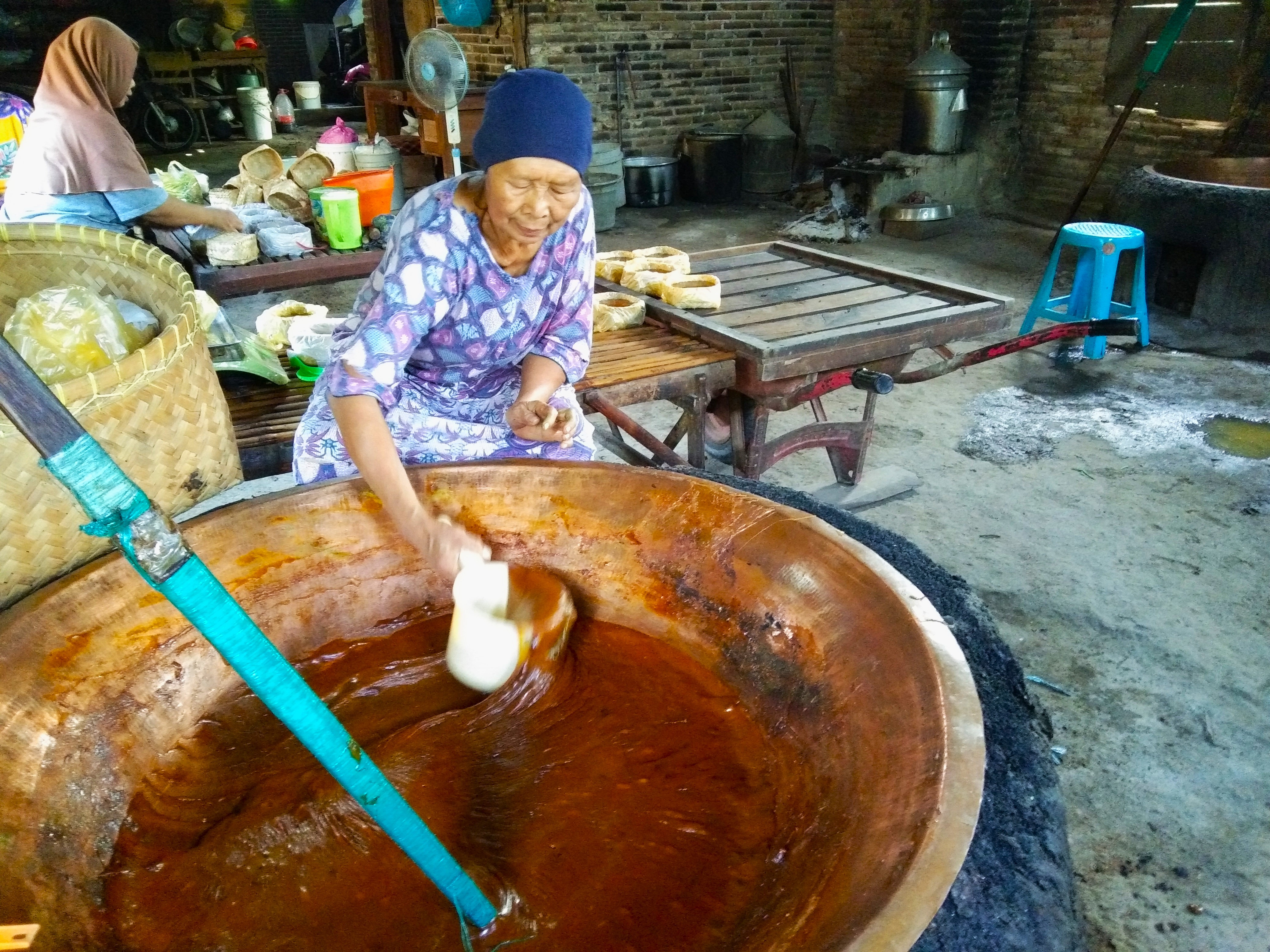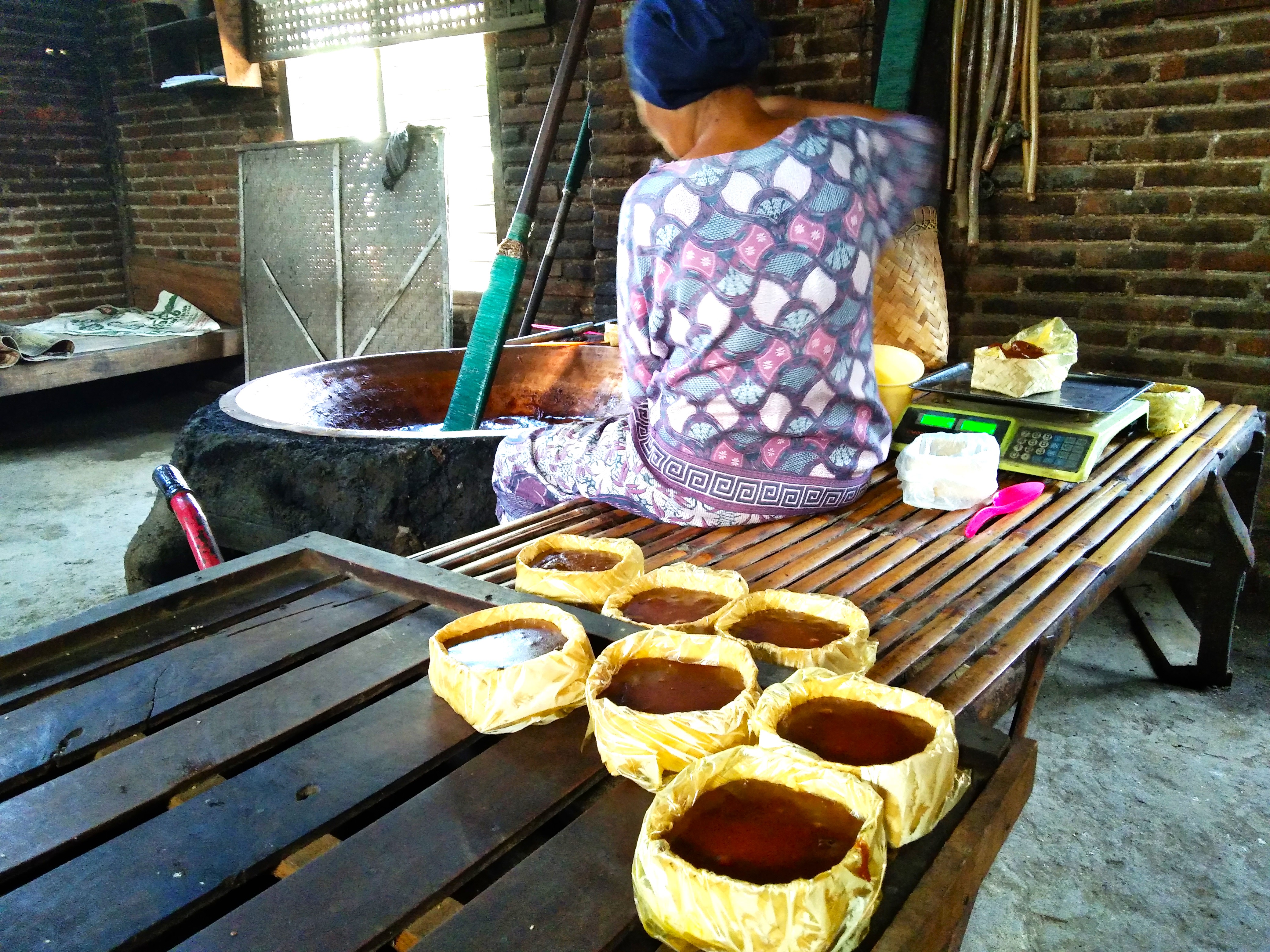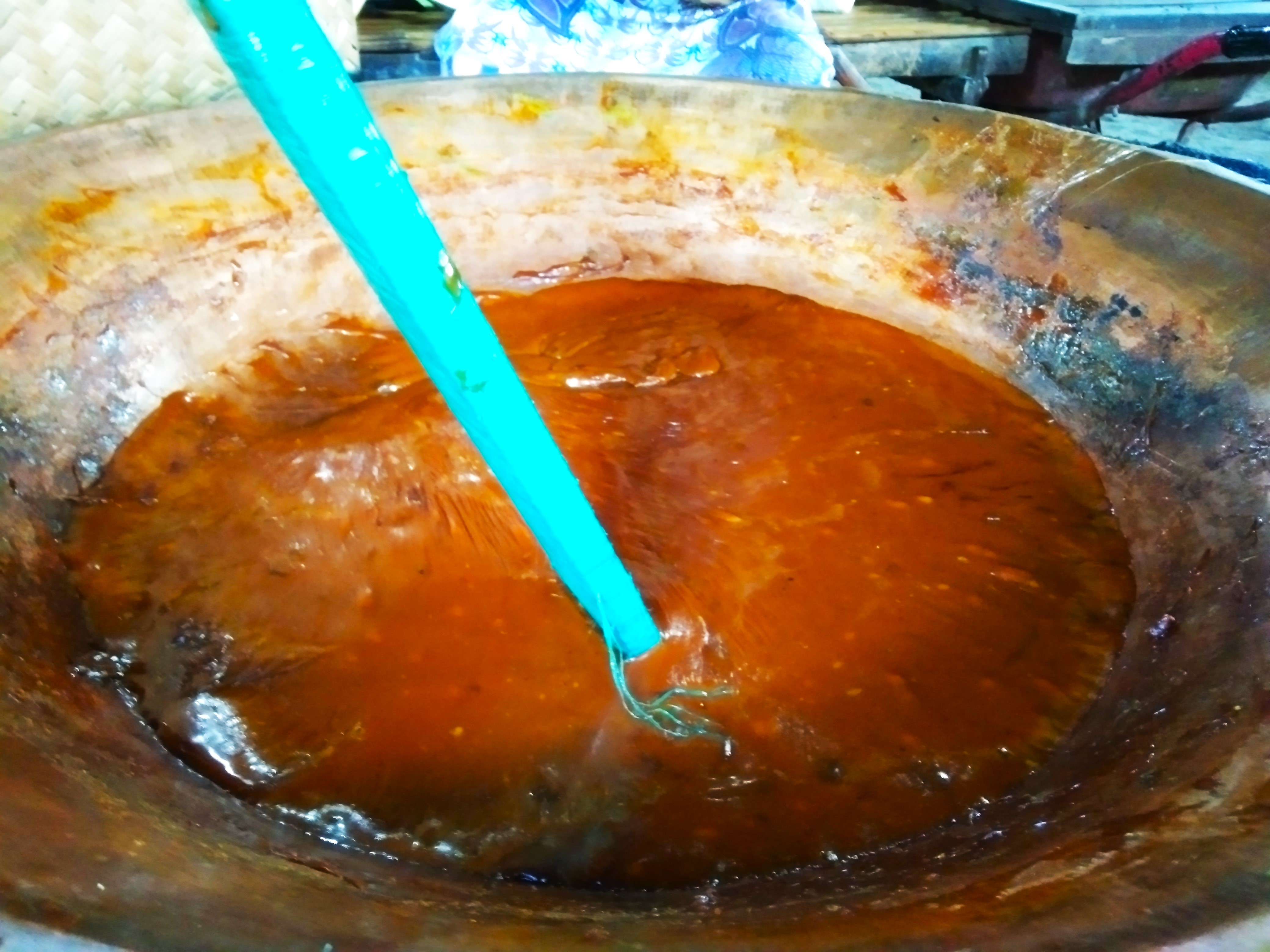
Kampung Jenang, From Sticky Rice and Brown Sugar, an Unspoken Bond is Formed
In small Blitar, not far from the city there is a village, one of the hamlets is nicknamed Kampung Jenang. This village may still be foreign to anyone who has just heard of it. It will be different for travelers who have visited it, they definitely do not want to erase their memories and interesting experiences. Every traveler who has visited and been involved in the process will get a similar experience and story, which is none other than the story of the experience of processing quality ingredients into jenan. Namely a sweet dish that symbolizes pride in their village.
Jenang, for the residents of Kampung Jenang, is not just food. It is a symbol of hereditary tradition. Every time the sun emits magenta color on the western horizon and the sky on the eastern horizon begins to turn red, each village family breaks the silence of the morning with their voices and activities in the kitchen. Cleaning equipment, making a fire with firewood in the kitchen, the gurgling sound of water filling the pots and from the sounds of stories and human laughter in the kitchen that add to the lively morning atmosphere.
One time, Sabato Kaliwuan cycled to explore the village to find Kampung Jenang along the footpath. He was fascinated to see the friendly residents in this quiet village atmosphere. It was as if this village had not been touched by many travelers with special interests in cycling and who liked traditional things. Sabato Kaliwuan cycled early from the city through alternative routes to avoid the hustle and bustle of vehicles on the main road.

Arriving at the village and entering Kampung Jenang, the quiet atmosphere typical of the village began to be felt. Cycling while observing the village environment, residents' houses, plants as hedges in the yards, and greeting residents who passed by. Occasionally inhaling a savory aroma. The curiosity triggered me to pedal a little faster to find where the source of the aroma came from, and what the aroma was.
In between pedaling the bike suddenly remembered information about jenang has a distinctive aroma. Because, it is made from ingredients that are indeed obtained from around the village. Some of them are: fresh pandan leaves, sticky rice produced from fertile rice fields, coconut milk from coconuts that grow around the village, and brown sugar produced from sap that is "deres" or squeezed directly from coconut trees. From some of these ingredients are combined with a composition according to the hereditary recipe that they got from the previous generation, which is then processed traditionally, so that it becomes jenang.
Sabato Kaliwuan couldn't wait to stop right where the aroma came from. From the sense of smell that was accustomed to the aroma of spices, then stopped at one of the production houses to immediately see how the jenang was made. Not only just looking, in his heart Sabato Kaliwuan also hoped to have the opportunity to be directly involved in the manufacturing process. After the turn, Sabato Kaliwuan stopped pedaling his bicycle. And, stopped right at one of the houses, which was the fourth house after the turn. Then Sabato Kaliwuan got off his bicycle, and led his bicycle into one of the yards. The house belonged to a mother named Darsih.

The homeowner who at that time happened to be in the yard drying something. Mrs. Darsih saw Sabato Kaliwuan who then introduced herself and explained the purpose of her visit. Mrs. Darsih replied with a smile, then she invited him into the house. She invited him to sit down, served a warm drink and invited Sabato Kaliwuan to drink. Then Mrs. Darsih accompanied him while telling him about Jenang.
In a casual conversation with Mrs. Darsih, Sabato Kaliwuan again conveyed the purpose of his visit, namely if he was allowed to see the process of making jenang, he would also be given the opportunity to be directly involved in the process. In Javanese culture, it is mandatory to maintain manners when speaking with people you have just met, maintain polite behavior, and ask for permission. Javanese society highly respects unwritten rules that have become a mutual agreement in Javanese culture, as Sabato Kaliwuan did to Mrs. Darsih. Manners are an important part of society and are highly respected. In fact, if we want to enter the kitchen, take pictures, we must ask permission first.
Mrs. Darsih smiled again while nodding her head as a sign of no objection, which could be interpreted as her acceptance of Sabato Kaliwuan's request. Then Mrs. Darsih told Sabato to finish his drink. Then she stood up while expressing words of invitation to enter the kitchen which was right next to her house. In Kampung Jenang, most of the kitchen locations are separate from the main house which can be called a "workshop", to minimize smoke from firewood entering the main house. And, most of them are also quite wide. Because in the kitchen there are indeed several places for processing, and there are also several people who have their respective tasks in processing jenang. And, in the kitchen there is no sophisticated equipment, all the work is done by human hands.
Mrs. Darsih explained to Sabato Kaliwuan the preparation process for making jenang, what ingredients must be prepared; starting from choosing fresh pandan leaves, choosing quality sticky rice, the composition of the mixture between coconut milk and sticky rice, and also Javanese sugar, how much heat is used to produce the perfect thickness of coconut milk. Mrs. Darsih emphasized one very important thing that: "in the process of making jenang, we are not just making food, but we always maintain the bond with history and also with the people we love who always accompany us". Then Sabato began to involve himself in the process of making jenang, of course with the guidance of the cooks.
In the kitchen, mingling with the people who are working. Sabato Kaliwuan began to feel a different nuance. Namely the nuance of togetherness built through communication, reminding each other. Their voices filled the kitchen space, starting from the sound of giving each other signals, reminding each other when the water was boiling, whether it was too big, joking and laughing combined with the sound made by metal equipment when filled with water, when cleaned and even when the water boiled the lid of the vessel rang, the crackling sound of fire burning wood. An atmosphere of togetherness that cannot be described by words. Sabato Kaliwuan also felt as if he was part of this small family, part of a tradition that had been established hundreds of years ago.
.jpg)
Villages, never separated from togetherness and the tradition of mutual cooperation. Mutual cooperation to clean the village, carry out village discussion activities, visit neighbors who are sick, or condolences if a family member dies. Helping with the funeral process, to helping the grieving family after the funeral process. Not only at death. If there is a family who is celebrating a wedding, all members of the community help prepare for the process. Starting from cleaning the yard and house, making symbols of joy that are installed on the road as markers to make it easier for friends who come from far away to easily find the house where the wedding is held. Mothers help cook for several days, and help with other preparations related to the wedding celebration.
Being in Kampung Jenang, Sabato Kaliwunan felt that he had found something more than just food with a sweet taste mixed with a savory taste. He had found the meaning of a tradition, togetherness, and love that is in every activity and every mouthful of jenang. He also witnessed harmony between residents even though they came from different backgrounds. They agreed on one vision, which is to always unite to always provide a distinctive taste to the jenang they make.
Time passed so quickly. He wanted to be able to stay longer with Mrs. Darsih's family and be a part of their history. It was already evening, and he had to pedal his bike again across a different road to the departure point. It took a few minutes to get there. Sabato Kaliwuan ensured that every serving of jenang served would provide a distinctive taste of hereditary heritage.
Bringing jenang home also brings a unique empirical experience, and memories of Ibu Darsih's family who gave her many things that she did not get anywhere else. The closeness that is able to change other people into part of the family is difficult to find in urban environments. Sticky rice, coconut milk, and Javanese sugar are a unity that cannot be separated. The sweetness of jenang is an expression of a sense of comfort because it really feels like being in a very warm "home" by the friendliness, smiles, sincerity and hard work of Ibu Darsih's family. In the kitchen, Sabato Kaliwuan witnessed how humans treat others. Laughter and jokes always break the silence that always becomes the spirit for anyone in the kitchen. Tiredness, fatigue, sweat, thirst are part of the process. After everything is finished, their fatigue and thirst are paid off by jenang with a perfect taste.
Travelers will not feel what Sabato Kaliwuan feels if they come to Kampung Jenang just to bring home jenang as a souvenir. The legendary deliciousness of jenang will not be perfect without feeling directly involved in the process of making jenang. Legendary can not only be seen from the end result. Being involved in the process is what will bring us to be able to feel what Mrs. Darsih's family feels, namely feeling the interweaving of historical traces of hereditary heritage through direct involvement to feel tired, exhausted, thirsty and sweaty in the kitchen and so on.
Mrs. Darsih's advice will not be forgotten, that "jenang is not just a finished product, it is a taste". Jenang is a bridge that always bridges the past with the future - the previous generation with the present generation. And, jenang is not just a dish, but to maintain its sustainability. This is one of the real steps to maintain cultural heritage and appreciate the values, creations, and intentions of the ancestors.
Sabato Kaliwuani brought home a souvenir in the form of jenang, a gift from Ibu Darsih. Every time he took a bite, he understood that it was not just food. Jenang is a story, an empirical experience, a tradition that will continue to live from generation to generation.
Kampung Jenang is a charm that will never fade. The richness of nature, culture, traditions that continue to flow in every drop of Javanese sugar, the fragrant green pandan leaves, the smiles and friendliness of the people. In Jenang village, where tradition and the sweet taste of life always go hand in hand, creating a story that will never fade.

How to Make Traditional Sticky Rice Jenang
Jenang ketan is a traditional Indonesian food made from sticky rice, coconut sugar, and coconut milk, which is cooked until it becomes a thick, sweet porridge. In general, jenang ketan is cooked in the traditional way, using wood as a fire source. This process not only gives a distinctive taste, but also makes jenang ketan have a more delicious aroma.
Ingredients Required:
1. White sticky rice- 1 kg (sticky rice must be washed clean and soaked in water for 2-3 hours to make it easier to cook)
2. Coconut sugar- 500 grams (coconut sugar can be grated or split so that it dissolves easily when cooked)
3. Coconut milk- 1 liter (obtained from grated coconut, if possible use fresh coconut milk for a better taste)
4. Water- 1 liter (for boiling sticky rice)
5. Pandan leaves- 3 sheets (to give a fragrant aroma to the jenang)
6. Salt- ½ teaspoon (to give a savory taste)
7. Firewood- As fuel for cooking
Equipment Required:
• Big cauldron(usually made of clay or thick metal)
• Wooden spoonto stir
• Tongue of fire(a place to cook with firewood)
• Bamboo woven container or besekfor a place to serve jenang
• Cloth filter(to strain the coconut milk if necessary)
Traditional Sticky Rice Jenang Making Process:
1. Preparation of Ingredients:
• Glutinous ricewashed clean and soaked for 2-3 hours. After that, drain.
• Coconut sugarfinely grated or cut into small pieces so that it dissolves quickly when cooked.
• Coconut milkStrain if necessary, so that there is no dregs that interfere with cooking.
• Pandan leavestied in a knot for easy retrieval during cooking.
2. Cooking Sticky Rice:
• Prepare a large pot and place it over a wood fire. The wood fire should be at medium heat so that the cooking process can proceed slowly.
• Put water in a skillet and boil with pandan leaves. After the water boils, add the soaked sticky rice.
• Cook the sticky rice over medium heat until it is half cooked (approximately 30-45 minutes). The sticky rice will become slightly transparent and look softer to the touch.
3. Adding Coconut Sugar and Coconut Milk:
• After the sticky rice is half cooked, add the grated coconut sugar. Stir well until the coconut sugar is completely dissolved in the dough.
• After the sugar has dissolved, pour in the coconut milk little by little while continuing to stir. Also add a little salt to balance the sweetness.
• Keep stirring the sticky rice jenang with a wooden spoon so that it doesn't burn on the bottom of the pan. This process takes about 30-45 minutes until the mixture begins to thicken and the texture becomes soft and thick.
This cooking process takes a total of about 1.5 to 2 hours, depending on the fire conditions and the amount of ingredients. You need to stir frequently so that the jenang does not stick to the bottom of the pan. Signs of the ripeness of the sticky rice jenang can be seen from the texture of the dough which is thick, not too runny, and looks soft but not runny. When the dough is stirred, it will pull slightly and stick to the wooden spoon. Another sign that the jenang is cooked is the distinctive aroma of pandan leaves and fragrant coconut milk and the aroma of melted coconut.
Once the jenang reaches the desired texture, remove from heat and let it cool slightly. To serve, you can place the sticky rice jenang in a besek (woven bamboo container) or serving plate. Sticky rice jenang is usually served warm. Some people also serve sticky rice jenang with grated coconut to make it more delicious.
After the sticky rice jenang is cooked and cool enough, it is ready to be served. You can put it in a besek or woven bamboo container. The bamboo container will give a traditional impression and add to the authentic taste of sticky rice jenang.
With this traditional method of making, sticky rice jenang not only has a distinctive taste, but also holds rich cultural values, providing warm memories for anyone who enjoys it.
Jenang is one of the traditional foods that has existed for a long time in Indonesia, especially in Java and Bali. This food has various variations depending on the region, and sticky rice jenang is one of the most famous forms of jenang. Sticky rice jenang is a sweet porridge made from sticky rice, coconut milk, and coconut sugar, which is cooked until thick.

History of Jenang
The Origin of Jenang:The origin of jenang can be traced in various historical literatures that describe this food as part of the Javanese culinary tradition. In Javanese, the word "jenang" refers to any type of food or porridge made from glutinous rice. This jenang is usually made in various events or traditional ceremonies, such as the celebration of the Javanese New Year (Satu Suro), ruwatan ceremonies, and other events related to the traditions and rituals of the Javanese people.
According to the book "Traditional Indonesian Food" by Mrs. Suryati Arifin (2004), jenang comes from the Javanese people's habit of using natural ingredients that are easily found around them, such as sticky rice, coconut milk, and coconut sugar. In Javanese tradition, jenang is not only considered as food, but also as a symbol of blessing and hope. This food is often served at thanksgiving events or ritual ceremonies as an offering to God and ancestors.
Influence of the Javanese Kingdom:The history of jenang can also be traced back to the golden age of kingdoms on the island of Java, such as the Majapahit Kingdom and the Islamic Mataram Kingdom. At that time, foods such as jenang were often used in various royal ceremonies. One recorded example is the use of jenang in the Sedekah Laut ceremony carried out by the coastal communities of Java. Jenang is considered to have magical powers and is believed to bring prosperity and ward off evil spirits.
Based on the records of "Pustaka Majapahit" published by Balai Pustaka, jenang is included in the category of traditional foods that are prepared with great care, using ingredients that must be specially selected. Usually, jenang is cooked under certain conditions to have a distinctive taste, and sometimes combined with spices or leaves to provide a certain aroma or taste.
Jenang in Social and Cultural Context
Jenang also has a place in the social life of the community. This food is often served at important events such as weddings, circumcisions, and welcoming events. On many occasions, sticky rice jenang is considered a symbol of warmth, togetherness, and good hopes. This is also seen in the use of jenang in Javanese traditional ceremonies, such as the Tumpengan Ceremony, where jenang is part of the offerings that symbolize gratitude and prayer.
As a traditional food, jenang is also presented in various forms and flavors. In some areas, sticky rice jenang is cooked with the addition of durian or nuts, providing a variety of different flavors and textures. The book "Food Typical of Java" by Joko Santosa (2010) notes that sticky rice jenang cooked using coconut milk and coconut sugar is very popular in the Yogyakarta and Solo areas, as well as in various other areas in Central Java.
In particular, sticky rice jenang (or better known as "jenang abang" or "jenang putih") in Java is often used in important celebrations, such as the Eid al-Fitr Celebration, the Satu Suro Celebration, or even in Thanksgiving Ceremonies. Sticky rice jenang using coconut milk and coconut sugar is cooked over low heat for several hours, so that the sugar dissolves and mixes perfectly with the sticky rice, producing a soft texture and natural sweetness.
Jenang ketan, made traditionally using wood fuel, is still maintained by the community to this day, showing the importance of cultural heritage in Indonesian social and culinary life.
